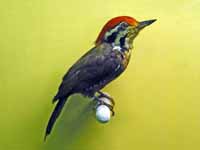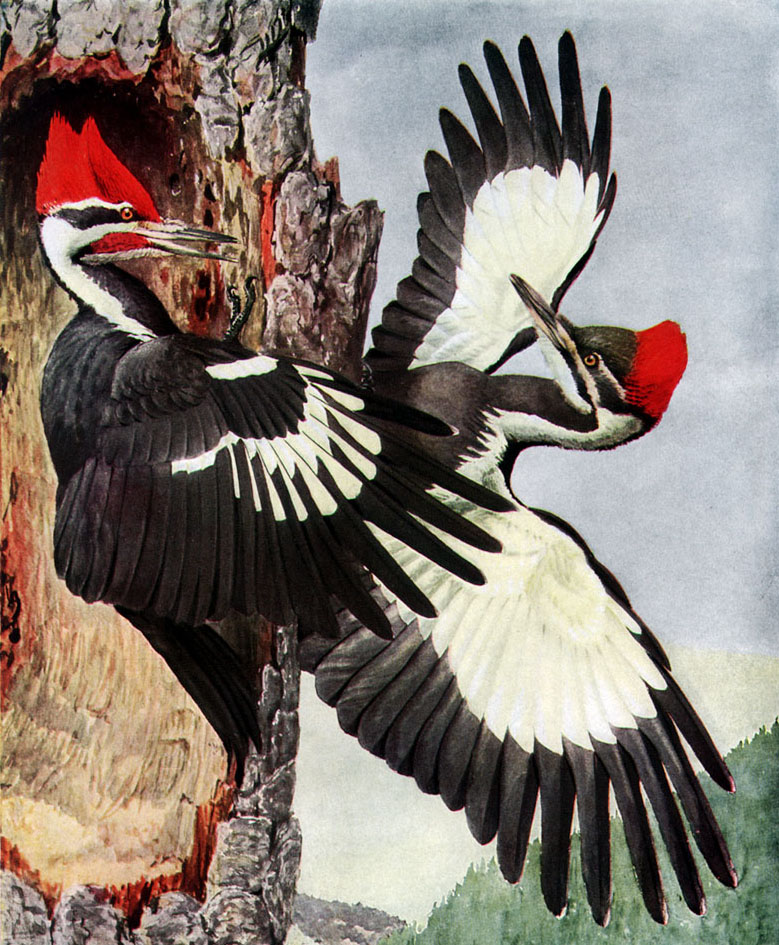The order Piciformes is made up of the woodpecker family Picidae plus 8 other families. Picidae make up about half of the species. In general, the Piciformes are insectivorous, but some exceptions eat mostly fruit. Nearly all Piciformes have parrot-like feet—two toes forward and two back, an arrangement that has obvious advantages for birds that spend much of their time on tree trunks. And most Piciformes do not have down feathers at any age, only true feathers. All nest in cavites.
Family Picidae: Woodpeckers and Allies
The woodpeckers family members are found almost worldwide. Most species live in forests or woodland habitats, although a few species are known to live in treeless areas such as rocky hillsides and deserts. They range in size from 8-50 cm. Many species exhibit patches of red and yellow on their heads and bellies, and these bright areas are important in signalling. Although the sexes of Picidae species tend to look alike, many have more prominent red or yellow head markings in males than in females.
Members of the family Picidae have strong bills for drilling and drumming on trees and long sticky tongues for extracting food. Species that use their bills in soil or for probing as opposed to regular hammering tend to have longer and more decurved bills. To prevent brain damage from the rapid and repeated decelerations, woodpeckers have evolved a number of adaptations to protect the brain. These include small brain size and the short duration of contact. The millisecond before contact with wood a thickened membrane closes, protecting the eye from flying debris. The nostrils are also protected, they are often slit-like and have special feathers to cover them. In addition to the strong claws and feet woodpeckers have short strong legs, this is typical of birds that regularly forage on trunks. The tails of most woodpeckers are stiffened, and when the bird perches on vertical surfaces, the tail and feet work together to support it. Picidae species can either be sedentary or migratory.
There are 7 articles pertaining to the woodpecker family Picidae: African, Eurasian, North America, South America, Small, Large, Terrestrial.
The largest woodpeckers belong to the following genera: Campephilus, Dryocopus,Chrysocolaptes and Dinopium. They are here because they have many similarities, the most eyecatching of which is their large size. When one of these species is encountered for the first time, the first impression my be "what is that large woodpecker?". You wil probably find the answer to that question here.
Genus Campephilus Found : mainly South America, also North America (Mexico)
These are large South American woodpeckers. The name means "lover of grubs". In addition to grubs, these species eat bettle, moths, berries, and fruit. They chip out holes, often quite large, while searching for food in trees. This chipping makes a loud hammering noise which makes their presence known. It is easy to determine that the noise is produced by a large woodpecker, beause the contact rate is much slower than that of a normal sized woodpecker.
About half of these species are 30 to 34 cm long which is also the range for all members of genus Chrysocolaptes. The other species are larger, with the Magellanic woodpecker being the largest woodpecker of its genus with a length of 36 to 45 cm and an average weight of 340 grams.
They make their nest in a hole they excavate in a tree. The height of their nest above the ground, 4 to 15 meters, varies with the trees available as well as the species. Both male and female excavate the nest cavity. The openning is oval, about 10 by 14 cm. The cavity extends about 30 cm below the bottom of the openning.
About half of these species are 30 to 34 cm long which is also the range for all members of genus Chrysocolaptes. The other species are larger, with the Magellanic woodpecker being the largest woodpecker of its genus with a length of 36 to 45 cm and an average weight of 340 grams.
They make their nest in a hole they excavate in a tree. The height of their nest above the ground, 4 to 15 meters, varies with the trees available as well as the species. Both male and female excavate the nest cavity. The openning is oval, about 10 by 14 cm. The cavity extends about 30 cm below the bottom of the openning.
Woodpecker,_Cream-backed Campephilus leucopogon
Description: The cream-backed woodpecker has black upperparts with a large cream colored stripe on the back. The underparts are also black. It has pale eyes, an ivory colored bill, and grey legs. The male has a red head with a black-and-white ear spot.The female has a black forehead, black forecrest, white malar stripe. It is 30 to 34 cm long and 200 to 280 grams. The cream-backed woodpecker has wider light colored stripe on back than does the similar Robust woodpecker.
Range: Argentina, Bolivia, Brazil, Paraguay, and Uruguay.
Habitat: Open woodland, savannah with clumps of trees, palm groves and farmland.
Diet: Mainly wood-boring beetle larvae. It forages on trees as well as on fallen logs and tree stumps.
Conservation status: Least Concern.
Image by: 1. 2, 3) Nick_Athanas - Argentina Range: Argentina, Bolivia, Brazil, Paraguay, and Uruguay.
Habitat: Open woodland, savannah with clumps of trees, palm groves and farmland.
Diet: Mainly wood-boring beetle larvae. It forages on trees as well as on fallen logs and tree stumps.
Conservation status: Least Concern.
1) Pair - male on top 2) Female 3) Male
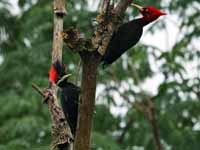
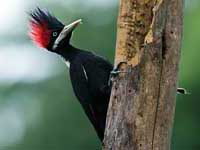
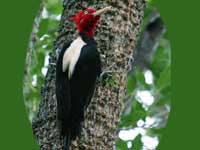
Woodpecker,_Crimson-bellied Campephilus haematogaster
Description:The crimson-bellied woodpecker has black upperparts, a red creasted head, and red underparts with some thin barring. It has an off-white face with a black eye-line. The female has some buff on the side of its neck, the male does not. They are 33 to 34 cm long and weigh 2235 to 250 grams. The crimson-bellied woodpecker has an off-white face awith black eye-line, the similar red-necked woodpecker has a red face.
Range: Panama, Columbia, Ecuador, Peru.
Habitat: Forests with tall trees, forest edges.
Diet: Insects, especially beetles and their larvae.
Conservation status: Least Concern.
Image by: 1, 2) Delahaye 3) Nick_Athanas - ColumbiaRange: Panama, Columbia, Ecuador, Peru.
Habitat: Forests with tall trees, forest edges.
Diet: Insects, especially beetles and their larvae.
Conservation status: Least Concern.
1) Female 2, 3) Male
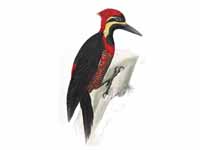
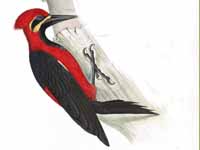
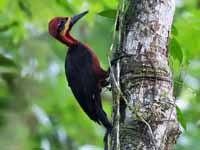
Woodpecker,_Crimson-crested Campephilus melanoleucos
Description: The cirmson-crested woodpecker has black upperparts, a red crest, white lines running down the sides of the black throat and shoulders, which meet in a V on the back, white underparts barred with black. The male has a red forehead, female a black forehead. Also, the male has a white patch on the cheek. It is 33 to 38 cm long and weighs 180 to 280 grams. The similar lineated woodpecker has parallel white lines on the back, not a V. The male Crimson-crested woodpecker has white above base of its bill, while the simila male Guayaquil woodpecker has red above base of bill. The female Crimson-crested woodpecker has a black forehead, while female Guayaquil woodpecker has red forehead.
Range: Northern and central South America.
Habitat: Forests and open woodland.
Diet: Mainly wood-boring insects and larvae, as well as ants, termites, small vertebrates and caterpillars.
Conservation status: Least Concern.
Image by: 1) Cláudio Timm - Brazil 2, 3) Dick Daniels - Panama 4) birdphotos.com - VenezuelaRange: Northern and central South America.
Habitat: Forests and open woodland.
Diet: Mainly wood-boring insects and larvae, as well as ants, termites, small vertebrates and caterpillars.
Conservation status: Least Concern.
1, 2) Female 3) ) Female on left, male on right 4) Male
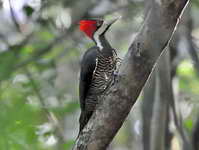
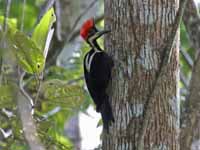
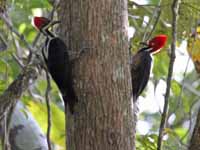
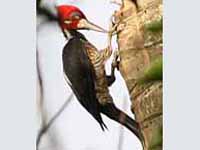
Woodpecker,_Guayaquil Campephilus gayaquilensis
Description: The Guayaquil woodpecker has black upperparts, a red crest, white lines running down the sides of the black throat and shoulders, which meet in a V on the back. The underparts are white barred with black. Adult females have a white line is replaced with red. A small white patch does remain. It is 32 to 34 cm long wand weighs about 240 grams. The similar male crimson-crested woodpecker has white above the base of bill, male Guayaquil woodpecker has red above there. The female crimson-crested woodpecker has a black forehead, the female Guayaquil woodpecker has is instead red.
Range: Columbia, Ecuador, Peru.
Habitat: Forests, forest edges, and secondary forests with tall trees.
Diet: Mainly wood-boring insects and larvae.
Conservation status: It is listed as Near Threatened because of clearing of forests which a has resulted in fragmentation of its range.
Image by: 1, 2, 3) Nick_Athanas -Peru, Ecuador, EcuadorRange: Columbia, Ecuador, Peru.
Habitat: Forests, forest edges, and secondary forests with tall trees.
Diet: Mainly wood-boring insects and larvae.
Conservation status: It is listed as Near Threatened because of clearing of forests which a has resulted in fragmentation of its range.
1, 2) Female 3) Male
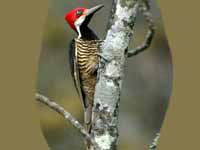
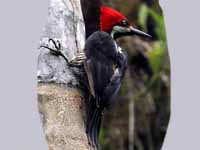
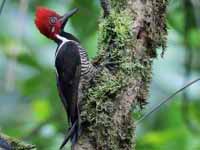
Woodpecker,_Magellanic Campephilus magellanicus
Description: The Magellanic woodpecker has a black body with white secondaries. Most species in this genus have a light colored bill, the Magellanic woodpecker has a black bill. The male has ared head while the female hasa black head. They both have an impressive crest. but the female's is usually larger. With a length of 36 to 45 cm and an average weight of 340 grams, the Magellanic woodpecker is the largest woodpecker of its genus and the largest in its range.
Range: Chile, Argentina.
Habitat: Forests, forest edges, and secondary forests with tall trees.
Diet: Mainly wood-boring beetle grubs and adult beetles. Also, spiders, reptiles, fruit, eggs, chicks.
Conservation status: Least Concern.
Image by: 1) Richard Crook 2) Dominic_Sherony 3) Liam Quinn - Agrentina 4) Serge_OuacheeRange: Chile, Argentina.
Habitat: Forests, forest edges, and secondary forests with tall trees.
Diet: Mainly wood-boring beetle grubs and adult beetles. Also, spiders, reptiles, fruit, eggs, chicks.
Conservation status: Least Concern.
1, 2) Female 3, 4) Male
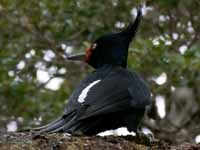
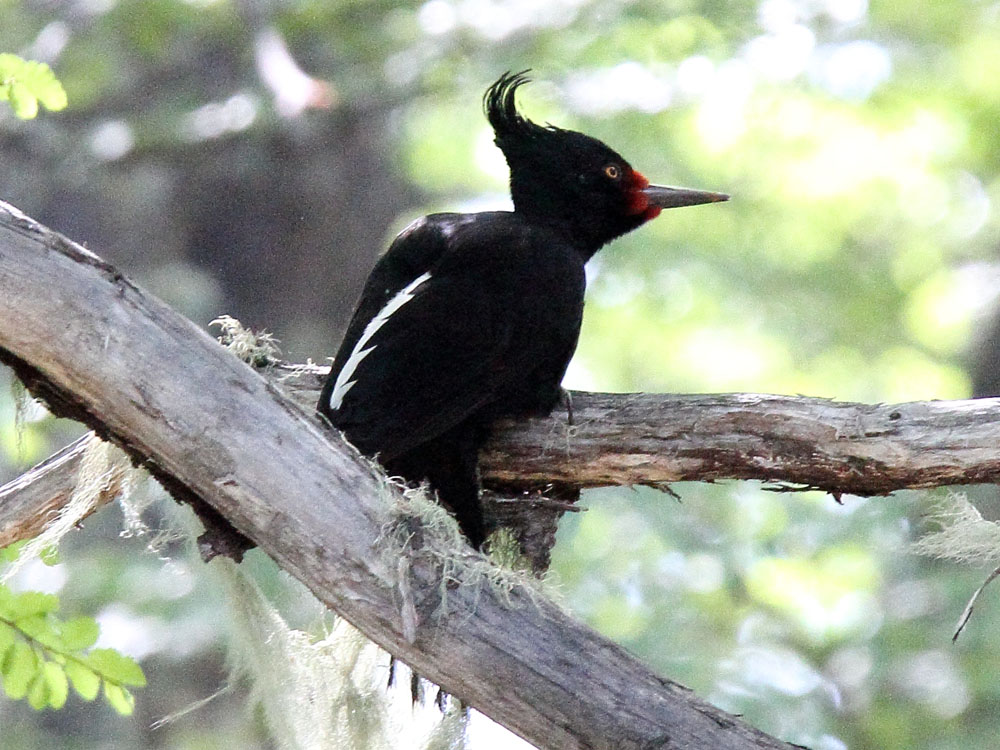
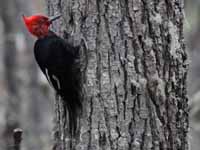
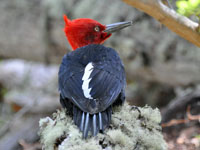
Woodpecker,_Pale-billed Campephilus guatemalensis
Description: The pale-billed woodpecker has a pale bill, as did the now extinct ivory-billed woodpecker. It has black upperparts except for white lines along side of neck that almost meet on its back to for a V. The underparts are white barred with grey.The male has red head, crest, and throat, The female has a mainly red head but the crest is black as is the throat. It is 37 cm long and weighs about 250 grams. The pale-billed woodpecker is larger that the similar lineated woodpecker which has a white line from the base of its bill to the neck.
Range: Mexico to Panama.
Habitat: Wet forests and adjacent second growth or semi-open woodland.
Diet: Mainly beetle larvae, also fruit, lizards
Conservation status: Least Concern.
Image by: 1) David_Gomez - Guatemala 2) llsproat 3) rob_StoeltjeRange: Mexico to Panama.
Habitat: Wet forests and adjacent second growth or semi-open woodland.
Diet: Mainly beetle larvae, also fruit, lizards
Conservation status: Least Concern.
1) Female 2, 3) Male
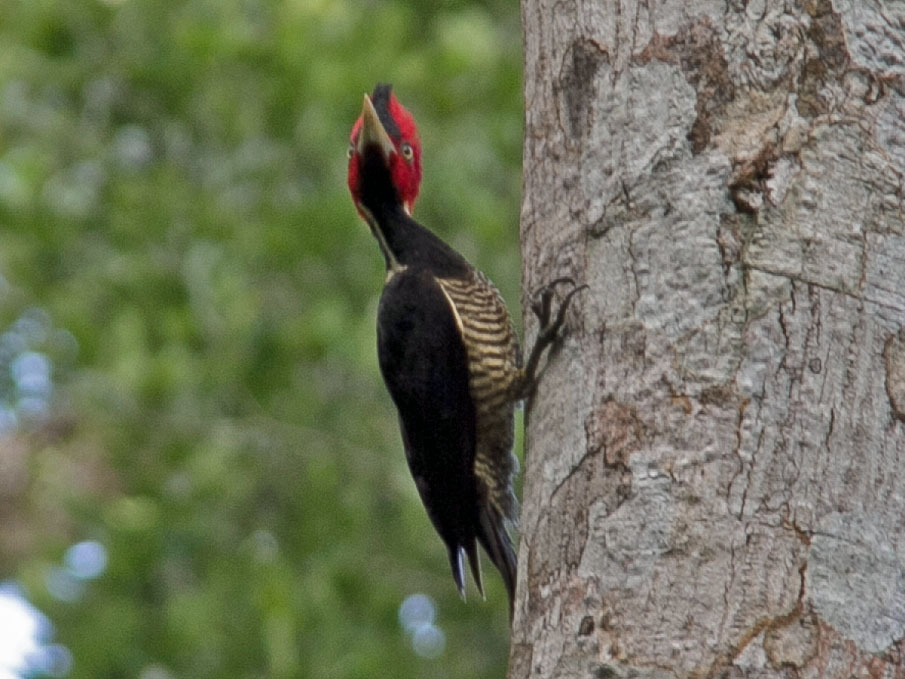
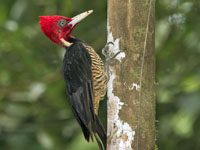
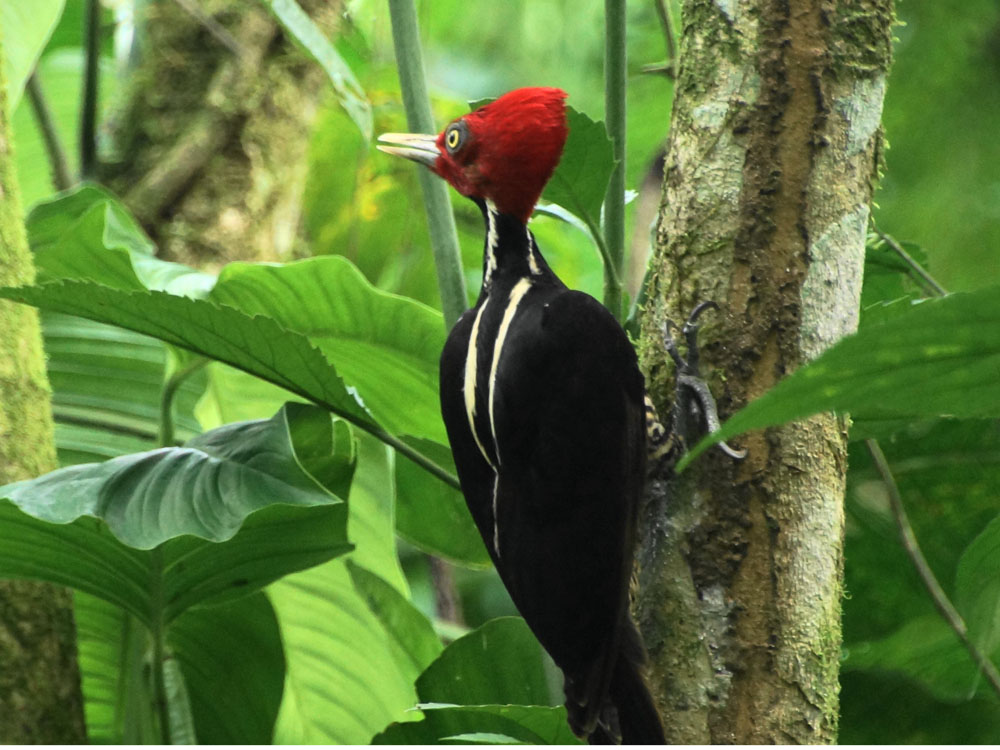
Woodpecker,_Powerful Campephilus pollens
Description: The powerful woodpecker has white lines running from the base of the bill, down the sides of the throat and shoulders, and meeting in a V on the back. The rest of the plumage is black, except the male has a red crest. It is 32 cm long The similar crimson-crested woodpecker has white underparts with black bars while the powerful woodpecker has black underparts.
Range: Colombia, Ecuador, Peru, and Venezuela..
Habitat: Dubtropical or tropical moist forests in the Andes. It is generally found at higher elevations than any other large woodpecker.
Diet: Information needed.
Conservation status: Least Concern.
Image: 1, 4) Nick_Athanas - Ecuador 2) Francesco Veresoni - EcuadorRange: Colombia, Ecuador, Peru, and Venezuela..
Habitat: Dubtropical or tropical moist forests in the Andes. It is generally found at higher elevations than any other large woodpecker.
Diet: Information needed.
Conservation status: Least Concern.
1) Female 2, 3) Male
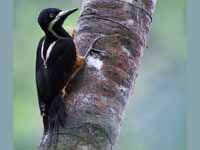
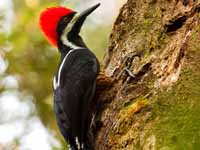
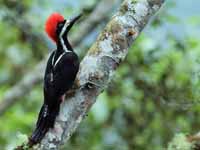
Woodpecker,_Red-necked Campephilus rubricollis
Description: The red-necked woodpecker has black upperparts and black tail. It has a red head, neck, and underparts. The male has a small black and white ear spot. It has yellowish-white eyes. The female has white at the base of bill and a little beyond. The red face of the red-necked woodpecker differentiates it from the similar crimson-bellied woodpecker.
Range: Central and northern South America.
Habitat: Various forests but not open areas.
Diet: Beetle grubs, moth larvae, also fruit.
Conservation status: Least Concern.
Image by: 1) Hector_Bottai - Brazil 2) Nick_Athanas - BrazilRange: Central and northern South America.
Habitat: Various forests but not open areas.
Diet: Beetle grubs, moth larvae, also fruit.
Conservation status: Least Concern.
1, 2 Female
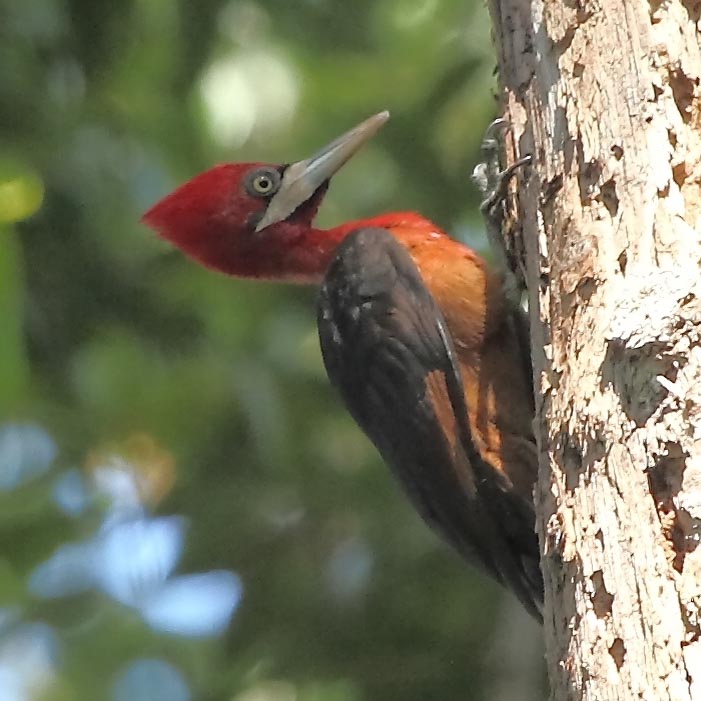
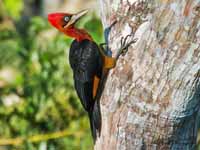
Woodpecker,_Robust Campephilus robustus
Description: The robust woodpecker has red head, throat, and neck. The white underparts are barred with black. There is no white line on neck. The male has a white and black ear spot while the female has a white malar stripe. It is 32 to 37 cm long and weighs 230 to 300 grams. The similar cream-backed woodpecker has a wider light colored stripe on its back than does the robust woodpecker.
Range: Argentina, Brazil, Paraguay.
Habitat: Humid forests, also disturbed forests that still has some tall trees.
Diet: Beetle grubs, beetles, berries.
Conservation status: Least Concern.
Image by: 1) Dario_Sanches 2) Cláudio Timm - Brazil 3) Nick_AthanasRange: Argentina, Brazil, Paraguay.
Habitat: Humid forests, also disturbed forests that still has some tall trees.
Diet: Beetle grubs, beetles, berries.
Conservation status: Least Concern.
1) Female 2, 3)_ Male
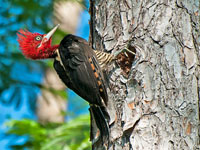
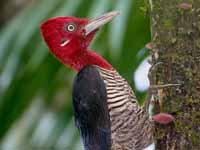
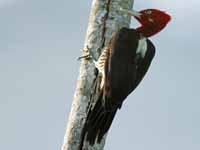
Genus Dryocopus Found : Asia, Europe, North America, South America
Three of these six species are found in the New World and the other three are found in the Old World.They are large powerful woodpecks that all have black backs and some red on their head, even the females. As was true for Campephilus woodpeckers, the Dryocopus woodpeckers chip out holes, often quite large, while searching for food in trees. Even though the Campephilus and Dryocopus woodpeckers are similar in many ways, they are not as closely related as once thought. In fact they belong to different tribes: Campephilini and Picini.
The black-bodied woodpecker is the smallest of the genus with a length of 29 to 30 cm.
The black woodpecker is probably the largesf ot the group with a length of 45 to 55 cm long and weight 250 to 400 grams. The pileated woodpecker maximum length is 49 cm, but it too can weigh up to 400 grams.
The black-bodied woodpecker is the smallest of the genus with a length of 29 to 30 cm.
The black woodpecker is probably the largesf ot the group with a length of 45 to 55 cm long and weight 250 to 400 grams. The pileated woodpecker maximum length is 49 cm, but it too can weigh up to 400 grams.
Woodpecker,_Andaman Dryocopus hodgei
Description: The Andaman woodpecker has mainly black plumage with a red crown. The female's forecrown is black instead of the mae's red. The eye is yellow, the sikin around it grey, the bill is black, and the legs are grey. The Andaman woodpecker is 38 cm long and weighs 150 to 250 grams.
Range: Andaman Islands of India.
Habitat: Lowland ra.
Diet: Insects on trees, but also ants on the ground.
Conservation status: It is listed as Vulnerable because of population growth in its limited range.
Image by: 1) Suhas_anand 2) India PostRange: Andaman Islands of India.
Habitat: Lowland ra.
Diet: Insects on trees, but also ants on the ground.
Conservation status: It is listed as Vulnerable because of population growth in its limited range.
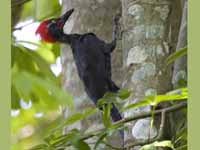
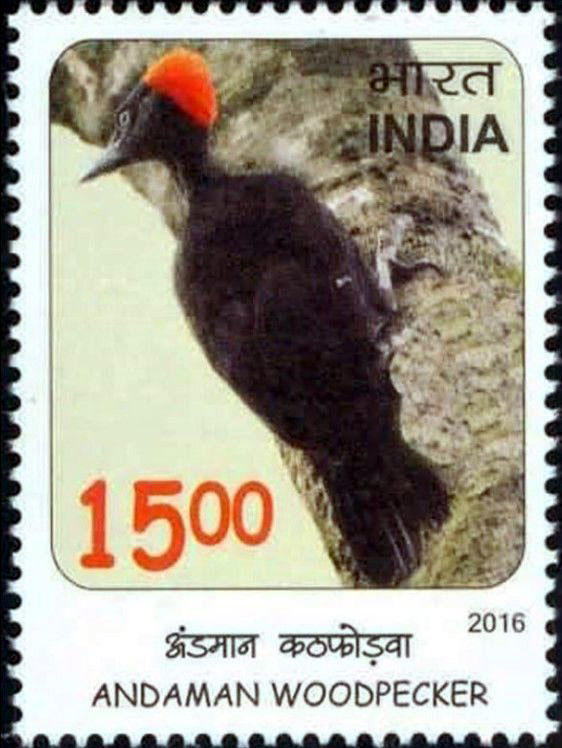
Woodpecker,_Black Dryocopus martius
Description: The black woodpecker is a crow-sized woodpecker. It is entirely black apart from a red crown. In males, the entire crown is red, but in females only the top hind-crown is red. The bill is ivory colored with a black tip. It has yellow eyes and dark grey legs. The black woodpecker is is 45 to 55 cm long and weighs 250 to 400 grams. It is the largest woodpecker in its range, and one of the largest in the world.
Range: From the Atlantic Ocean in Europe to the Pacific Ocean in Asia.
Habitat: Forests. During the nonbreeding season it may visit more open woods.
Diet: Carpenter ants, beetle grubs, beetles. Also other anthropods, fruit.
Conservation status: Least Concern.
Image by: 1) hedera_baltica - Poland 2) Cesare_Dolzani - Italy 3)Alastair Rae - Finland 4) Andy_Li Range: From the Atlantic Ocean in Europe to the Pacific Ocean in Asia.
Habitat: Forests. During the nonbreeding season it may visit more open woods.
Diet: Carpenter ants, beetle grubs, beetles. Also other anthropods, fruit.
Conservation status: Least Concern.
1) Female 2) Male
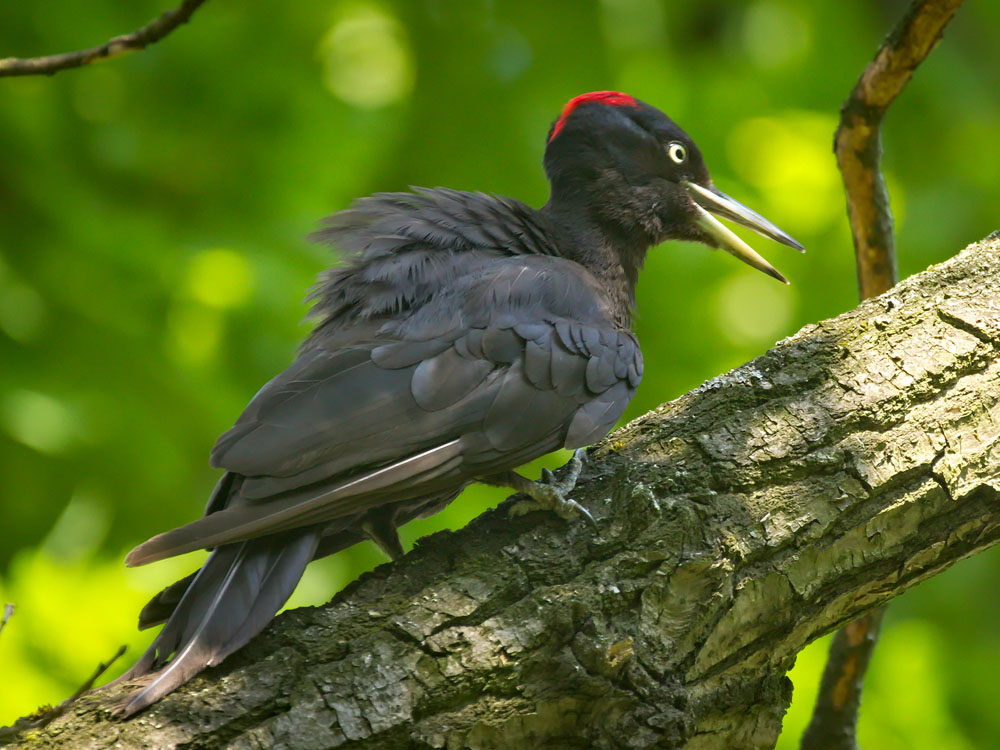
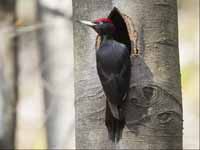
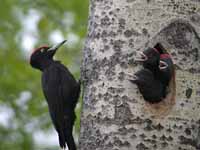
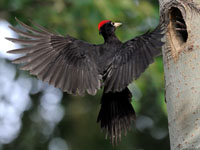
Woodpecker,_Black-bodied Dryocopus schulzi
Description: The black-bodied woodpecker has mainly black plumage. It has a broad white neck stripe, usually a white shouder stripe, and a red crest. It has grey ear coverts, yellow nasal tuft, pale bill, and dark grey legs. black-bodied woodpecker. The male has a red malar region. The black-bodied woodpecker is 29 to 30 cm long.
Range: Mainly Argentina, Paraguay. Also Bolivia.
Habitat: Mainly woodland, also savanna with some trees and scrubs.
Diet: Insects found on trees.
Conservation status: It is listed as Near Threatened because expanding agricuture has caused deforestation. They are now rarely seen.
Image by: 1) Leonel_Roget 2) Tony_Morris - ParaguayRange: Mainly Argentina, Paraguay. Also Bolivia.
Habitat: Mainly woodland, also savanna with some trees and scrubs.
Diet: Insects found on trees.
Conservation status: It is listed as Near Threatened because expanding agricuture has caused deforestation. They are now rarely seen.
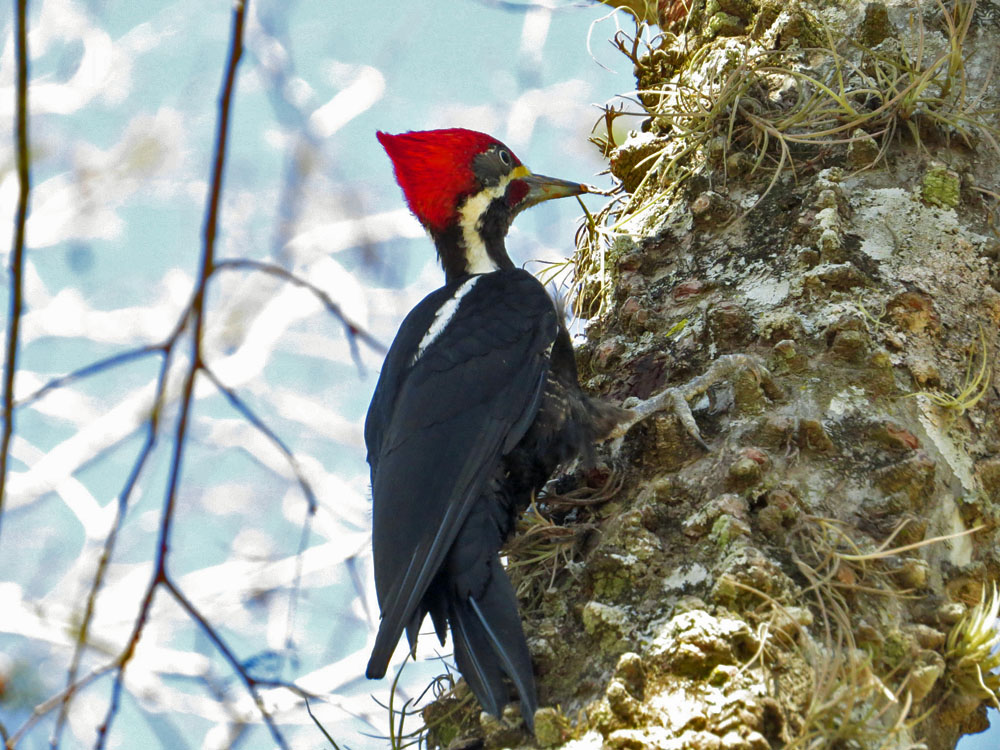
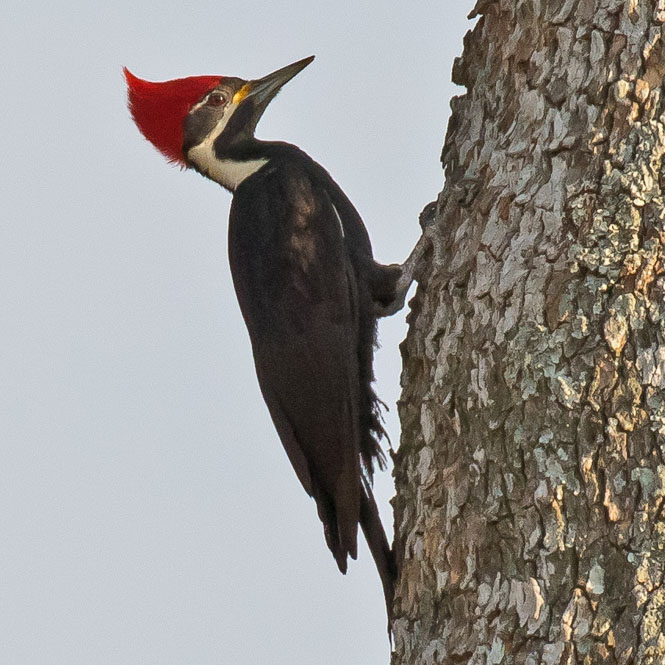
Woodpecker,_Lineated Dryocopus lineatus
Description: The lineated woodpecker has black upperparts. There are white lines from base of bill continuning down the neck and then vertically down the back (birds from southeastern part of range sometimes lack the lines on the back). It has white underparts barred with black, and a red crest. The bill usually black but may be pale. Males have a red forehead and a red line from the base of the bill which extends almost to the throat. The red line usually a black border. In adult females, these features are black, except they may might be a little red at the base of the bill. It is 31 to 36 cm long. The similar crimson-crested woodpecke has white lines on the back that form a V while the lineated woodpecker has parallel white lines on the back.
Range: Mexico to the top half of South America.
Habitat: Forest borders and open woodlands. It is rare in mountains.
Diet: Mainly ants, beetles, grubs. Also seeds, fruit.
Conservation status: Least Concern.
Image by: 1) Nick_Athanas - Ecuador 2, 3, 4) Dario
Sanches - Brazil Range: Mexico to the top half of South America.
Habitat: Forest borders and open woodlands. It is rare in mountains.
Diet: Mainly ants, beetles, grubs. Also seeds, fruit.
Conservation status: Least Concern.
1, 2) Female 3, 4) Male
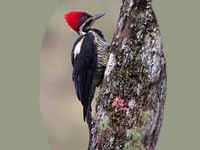
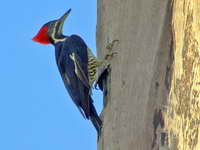
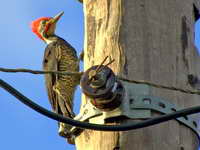
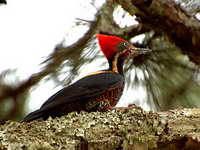
Woodpecker,_Pileated Dryocopus pileatus
Description: The pileated woodpecker has black upperparts and lowerparts, plus a white the throat and neck. There is a black line on the nape and a black eye-line. The male has red stripe above the chin, female has black stripe. It is 40 to 49 cm long and weighs 225 to 400 grams. The pileated woodpecker is the largest woodpecker in its range, and one of the largest in the world. It is similar to the lineated woodpecker, but theiir ranges do not overlap.
Range: North America.
Habitat: Mainly large, mature hardwoods.
Diet: Insects such as carpenter ants, beetle larvae. Also fruit, berries, nuts.
Conservation status: Least Concern.
Image by: 1) Dick Daniels - North Carolina 2) Dick - Sandwich, New Hampshire 3, 4) Alan
D Wilson -
Black Creek, British ColumbiaRange: North America.
Habitat: Mainly large, mature hardwoods.
Diet: Insects such as carpenter ants, beetle larvae. Also fruit, berries, nuts.
Conservation status: Least Concern.
1, 2) Female 3, 4) Male
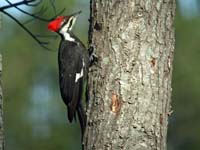
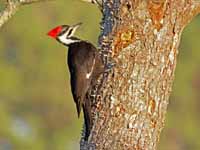
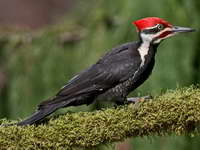
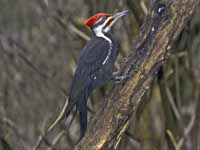

Woodpecker,_White-bellied Dryocopus javensis
Description: The white-bellied woodpecker has many subspecies of varying appearance. All have mainly black plumage, a red crown, and white on some of the underparts. Some have white on face or throat. The male has a red forehead and malar stripe, on the female these are black. It is 40 to 48 cm long and weighs 200 to 350 grams which makes it a little smaljer than the similar black woodpecker which is all black except for its red crown,
Range: South and Southestern Asia.
Habitat: Forests, forests with tall trees, forest edges.
Diet: Ants, beetle larvae, betles. It searches in standing trees, fallen trees and logs, even among leaf litter.
Conservation status: Least Concern.
Range: South and Southestern Asia.
Habitat: Forests, forests with tall trees, forest edges.
Diet: Ants, beetle larvae, betles. It searches in standing trees, fallen trees and logs, even among leaf litter.
Conservation status: Least Concern.
Image by: 1) Rahul Alvares 2) Nara Simhan 3) Jayanth Sharma 4) Sergey Yeliseev - Vietnam
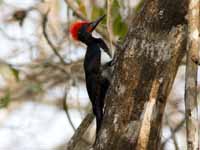
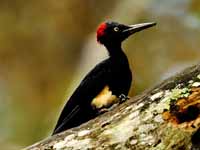
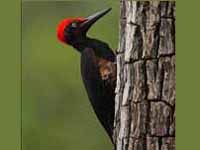
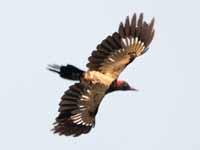
FLAMEBACK WOODPECKERS
There are two genera of woodpeckers that have species called flamebacks: Chrysocolaptes and Dinopium. The first is asigned to tribe Campephilini and the latter to tribe Picini. Even though they are not closey related, these flameback genera are present in the same article to aid in their identication.
Genus Chrysocolaptes Found : Asia
These woodpeckers are known as flameback. zygodactyl or "yoked" feet, with two toes pointing forward, and two backward. The long tongue can dart forward to capture insects. For similar Asian woodpeckers see also Dinopium, Dryocopus. They are 28 to 34 cm long.
Flameback,_Buff-spotted Chrysocolaptes lucidus
Description: The buff-spotted flameback has red upperparts, reddish buff face, and a red rump. The underparts are buff with heavy spotting. It has a black tail. The male has a red forehead and crown while they are olive-brown on the female. The buff-spotted flameback is 28 to 34 cm long and about 125 grams. It was formerly considered to be a sub-species of the greater flameback.
Range: Philippines.
Habitat: Primary and secondary forests, also near settlements.
Diet: Probably caterpillars, beetles and their grubs, ants.
Conservation status: Least Concern.
Image by: 1) Carmeloabad Range: Philippines.
Habitat: Primary and secondary forests, also near settlements.
Diet: Probably caterpillars, beetles and their grubs, ants.
Conservation status: Least Concern.
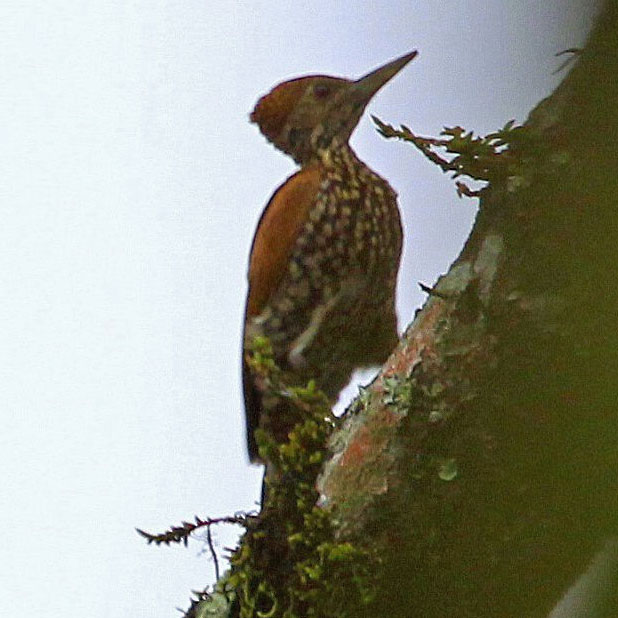
Flameback, Crimson-backed Chrysocolaptes stricklandi
Description: The crimson-backed flamebook has dark red upperparts and rump, The male's head is black with a red crown and crest. He has a white supercilium which is made from a line of dots. The female's head is entirely black except for lines of white dots. The underparts are white with dark markings. The throat is also white. The crimson-backed flamebook is 29 to 30 cm long.
Range: Sri Lanka.
Habitat: Wooded areas.
Diet: Beetles and ants plus their larvae. Also some plant material.
Conservation status: Least Concern.
Image by: 1) David_Cook 2) Hafiz Issadeen 3) Gihan_JayaweeraRange: Sri Lanka.
Habitat: Wooded areas.
Diet: Beetles and ants plus their larvae. Also some plant material.
Conservation status: Least Concern.
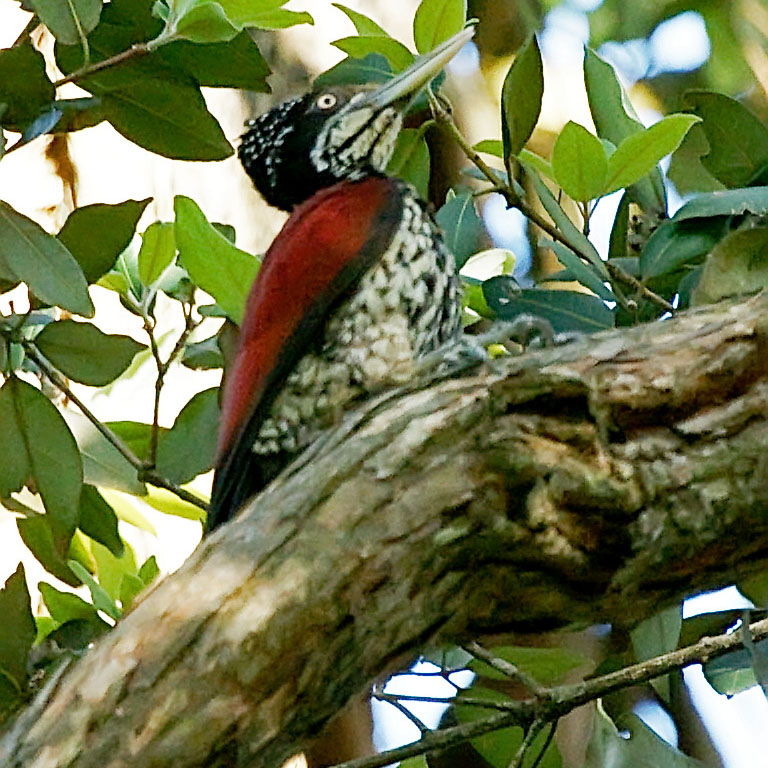
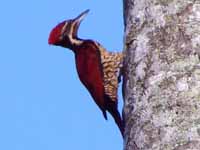
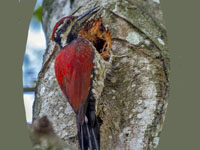
Flameback, Greater Chrysocolaptes guttacristatus
Description: The greater flameback, aka the greater goldenback, has unmarked golden yellow to dark brown upper-back and wings. The lower-back and rump are red. The underparts are whitish with dark markings. It has a black tail and white to yellowish eyes. The male has a red crest while the female's is various colors depending on the subspecies, but not red. They have a wide black eye-line that contines down the nape. That black is bordered above by a narrow white line. The upper-throat is white with some black lines. The greater flameback is about 33 cm long. The similar black-rumped Flameback has a black throat while the greater flameback has a white upper-throat. The similar common flameback. has a mainly white face while the greater flameback has a mainly black face.
Range: Indian subcontinent, eastwards to southern China, Southeast Asia
Habitat: Open woodlands with tall trees, including some dead ones.
Diet: Beetles, grubs, caterpillars, ants, other insects.
Conservation status: Least Concern.
Image by: 1) Arindam Mitra - India 2, 3) Vijay Anand Ismavel 4) Rushen - ThailandRange: Indian subcontinent, eastwards to southern China, Southeast Asia
Habitat: Open woodlands with tall trees, including some dead ones.
Diet: Beetles, grubs, caterpillars, ants, other insects.
Conservation status: Least Concern.
1, 2) Female 3, 4) Male
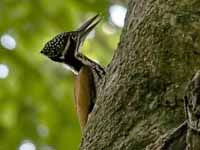
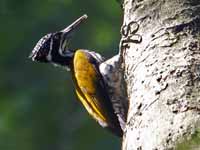
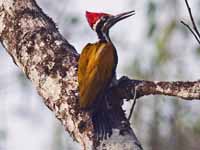
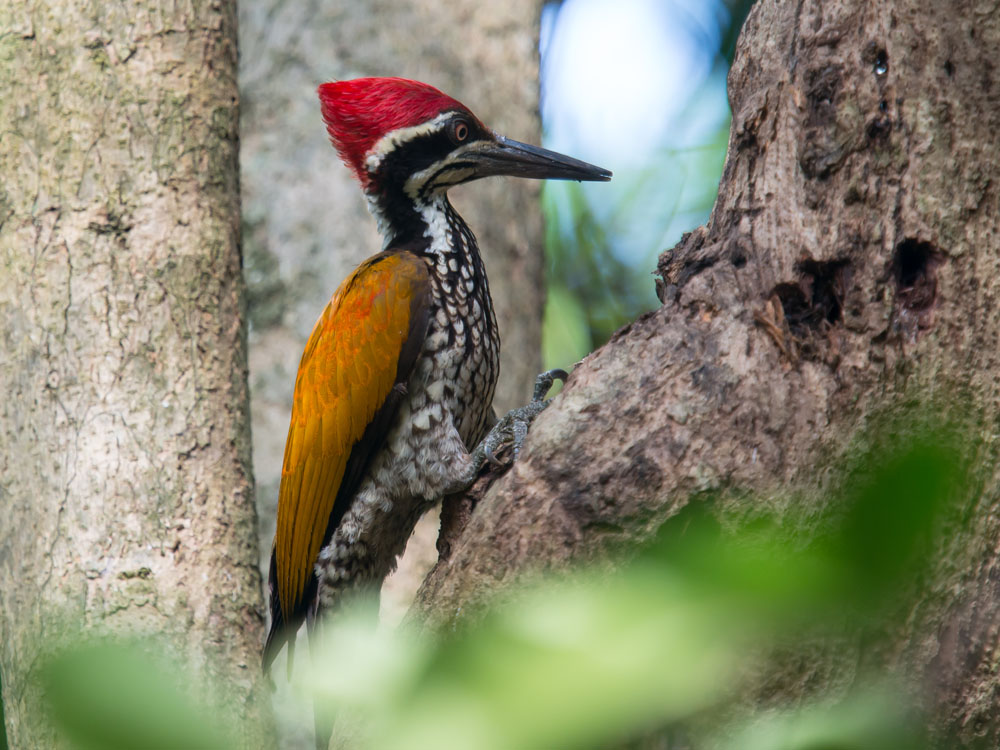
Flameback,_Javan Chrysocolaptes strictus
Description: The Javan flameback has yellowish to green upperparts with green wing-coverts. The male has a red crown while the female has a yellow crown. They have a wide black eye-line that continues to the nape with a white supercilium border above. Below the eye-line is a white moustachial border, a black line, and then a white malar stripe. The throat is white with a thin black center line.The Javan flameback has whitish underparts with dark marks. It is 28 to 32 cm long.
Range: The Javan flameback has.
Habitat: Open woodlands with tall trees, mangroves, plantations.
Diet: Probably.
Conservation status: It is listed as Vulnerable since the population of about 10,000 seems to be decreasing because of habitat loss.
Image by: 1) Francesco_Veronesi - JavaRange: The Javan flameback has.
Habitat: Open woodlands with tall trees, mangroves, plantations.
Diet: Probably.
Conservation status: It is listed as Vulnerable since the population of about 10,000 seems to be decreasing because of habitat loss.
1) Male
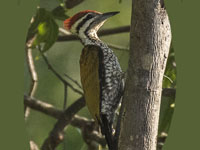
Flameback,_Luzon Chrysocolaptes haematribon
Description: The Luzon flameback has dull red upperparts with blackish nape and upper-back. The male has a dull red crown and crest while the on the female they are black with white spots. They have a dotted white supercilium, black post-ocular stripe, with a buffy-yellow malar. The underparts are buffy with black marks. It is 28 to 32 cm and weighs about 130 grams.
Range: Philippines.
Habitat: Woodland and plantations with some large trees.
Diet: Probaby about the same as other members of the genus.
Conservation status: Least Concern.
Image by: 1, 2) ChetatataRange: Philippines.
Habitat: Woodland and plantations with some large trees.
Diet: Probaby about the same as other members of the genus.
Conservation status: Least Concern.
1) Female 2) Male
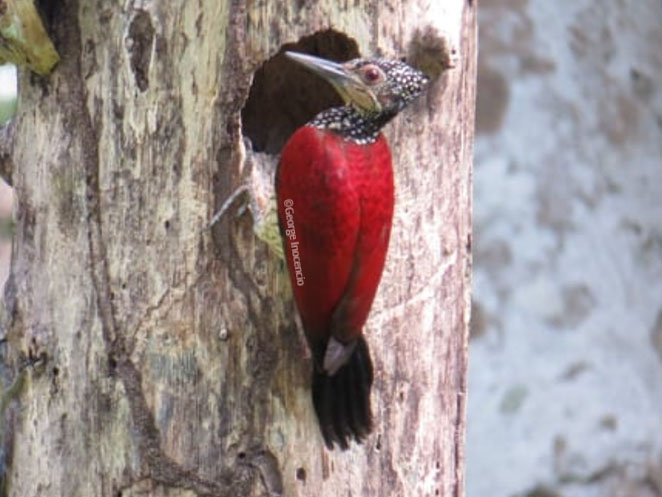
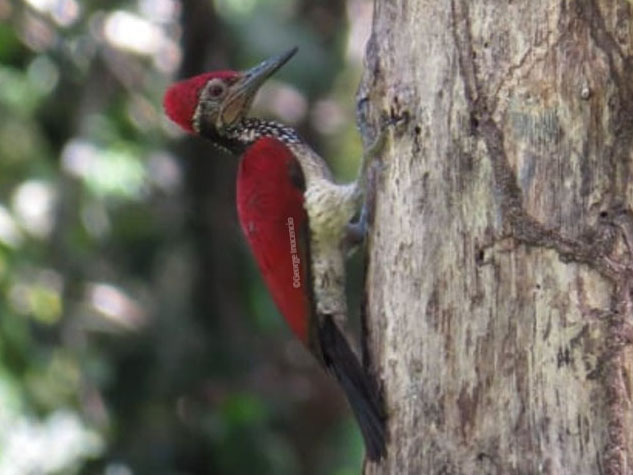
Flameback,_Red-headed Chrysocolaptes erythrocephalus
Description: The red-headed flameback has bright green upperparts with some red on the lower back. It has red rump. The head is red with a dark ear patch. The female has yellow spots on its crown. The underparts are white with dark stripes on the breast and dark spots on the belly. The bill is yellowish, the eyes are dark red, and the legs greyish. It is 28 to 34 cm long. The similar spot-throated flameback has two bold black stripes on its face.
Range: Philippines.
Habitat: Forest and edge, where at least some large trees remain,
Diet: Information needed. Since it is sometimes considered a subspecies of the greater flameback, probably beetles, grubs, caterpillars, ants, other insects.
Conservation status: The Red-headed Flameback is listed as Endangered because of its linited range where its habitat is decreasing.
Image by: 1) John_Gerrard_Keulemans 2) Adri Constantino - PalawanRange: Philippines.
Habitat: Forest and edge, where at least some large trees remain,
Diet: Information needed. Since it is sometimes considered a subspecies of the greater flameback, probably beetles, grubs, caterpillars, ants, other insects.
Conservation status: The Red-headed Flameback is listed as Endangered because of its linited range where its habitat is decreasing.
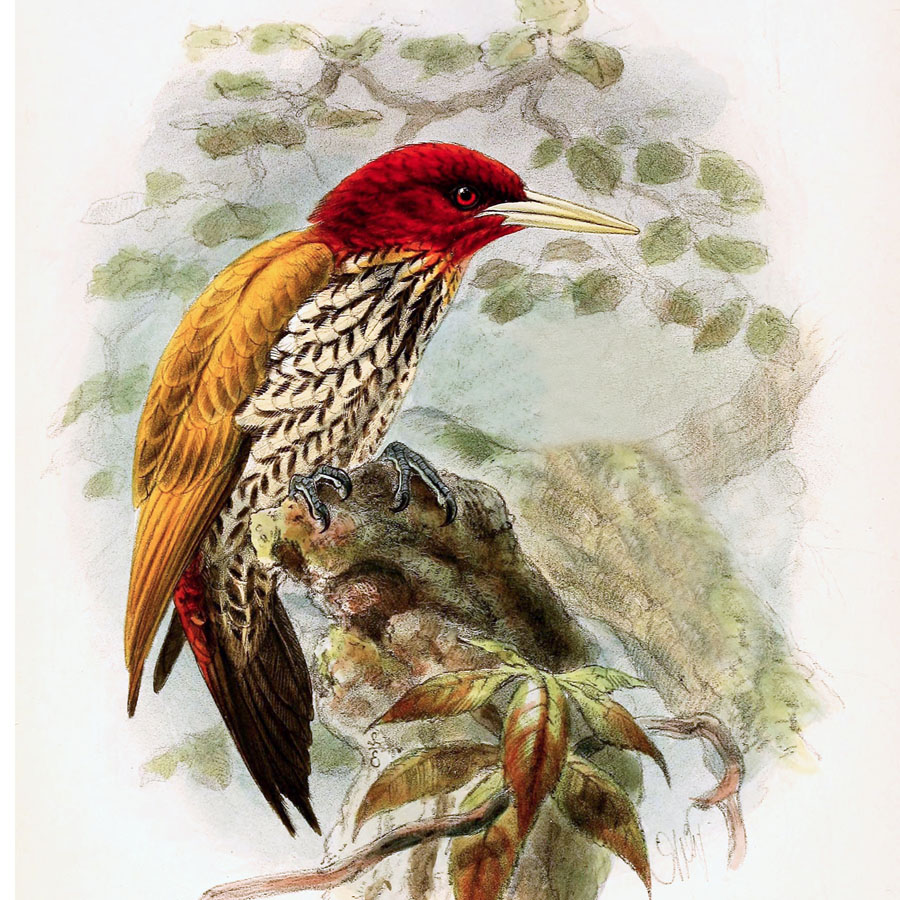
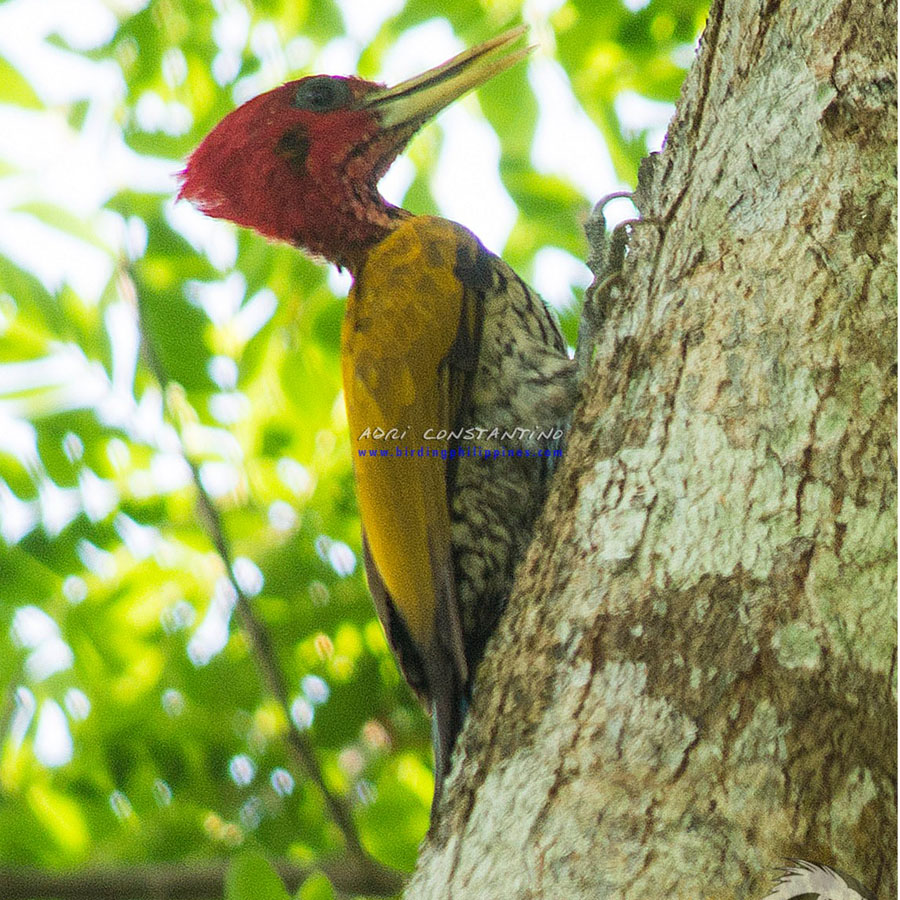
Woodpecker,_White-naped Chrysocolaptes festivus
Description: The white-naped woodpecker has a white nape that extends down the back. A bold black eye-line extends down the neck continuing down the back creating a V-shaped border of the nape's white. The remaining upperparts are golden as are the wings. There is white above the black eye-line. It has a black tail and rump. The underparts are white with black chevrons. The male has red crown and the female has a yellow crown. The white-naped woodpecker is about 29 cm long and weighs about 210 grams.
Range: India, Sri Lanka.
Habitat:Oopen forest, also scrub with some trees.
Diet: Larvae of wood boring insects, ants. Also fruit.
Conservation status: Least Concern.
Image by: 1) Ananda Debnath 2, 3) JM Garg - IndiaRange: India, Sri Lanka.
Habitat:Oopen forest, also scrub with some trees.
Diet: Larvae of wood boring insects, ants. Also fruit.
Conservation status: Least Concern.
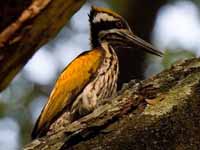
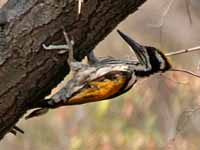
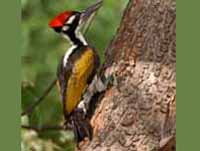
Flameback,_Yellow-faced Chrysocolaptes xanthocephalus
Description: The yellow-faced flameback has red upperparts and rump. It has a black tail, a yellow belly and cheek, and a black neck with large white spots. The male has a red crown and the female a yellow one. It is 28 to 32 cm long.
Range: Philippine islands of Negros and Panay
Habitat: Lowland forests and plantations. Tall trees are required.
Diet: Information needed. Since it is sometimes considered a subspecies of the greater flameback, probably beetles, grubs, caterpillars, ants, other insects.
Conservation status: It is listed as Endangered. It recently became extinct on the Philippine Island of Guimaras, Masbate, and Ticao. It is struggling on its two remaining islands because of deforestation.
Image by: 1) John_Gerrard_KeulemansRange: Philippine islands of Negros and Panay
Habitat: Lowland forests and plantations. Tall trees are required.
Diet: Information needed. Since it is sometimes considered a subspecies of the greater flameback, probably beetles, grubs, caterpillars, ants, other insects.
Conservation status: It is listed as Endangered. It recently became extinct on the Philippine Island of Guimaras, Masbate, and Ticao. It is struggling on its two remaining islands because of deforestation.
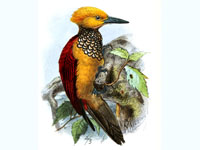
Genus Dinopium Found : Asia
These are large Asian flamebacks. For similar Asian woodpeckers see also Chrysocolaptes.
Flameback, Black-rumped Dinopium benghalense
Description: The black-rumped flameback, aka the lesser golden-backed woodpecker, has mainly golden-yellow upperparts, including the wing coverts. The upper-mantle is black as are the nape, rump, and upper-tail. The male has a red crown while the female has a black crown. The face is white wiith a black eye-line. There are white flecks on the black throat.
It has white underparts with dark chevron markings. The black-rumped flameback is 26 to 29 cm long and weighs 85 to 135 grams. The similar greater Flameback has a white throat,
Range: Indian subcontinent.
Habitat: Open forests, urban areas with wooded avenues.
Diet: Beetle larvae from under the bark, termites for their moundsk fruit, food scraps.
Conservation status: Least Concern.
Image by: 1) Challiyil Vipi - India 2) Muzaffar Bukhari - Pakistan 3, 4) J M Garg - IndiaRange: Indian subcontinent.
Habitat: Open forests, urban areas with wooded avenues.
Diet: Beetle larvae from under the bark, termites for their moundsk fruit, food scraps.
Conservation status: Least Concern.
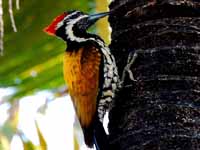
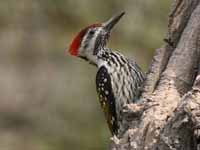
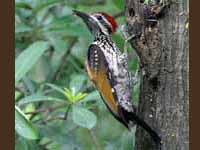

Flameback,_Common Dinopium javanense Found: Asia
Description: The common flameback has mainly golden-yellow upperparts, including the wing coverts. The top of the mantle is black as are the nape and upper-tail. The rump is red. The male has a red crown while the female has a black crown with thin white streaks. The face is white wiith a black eye-line and a long black moustachial stripe.
It has a white throat. The underparts are also white but they have a black scaly pattern. The black-rumped flameback is 28 to 30 cm long. The similar greater flameback has a mostly black face while the common flameback has a mostly white face.
Range: Southeast Asia; also the west coast of India.
Habitat: Wide variety of woodlands.
Diet: Insects such as ants, larvae; also scorpians.
Conservation status: Least Concern.
Image by: 1, 2, 3) Lip Kee - Singapore 4) Johnny Wee Range: Southeast Asia; also the west coast of India.
Habitat: Wide variety of woodlands.
Diet: Insects such as ants, larvae; also scorpians.
Conservation status: Least Concern.
1) Female 2 - 4) Male
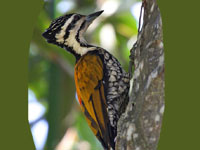
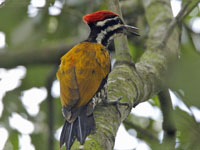
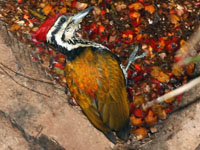
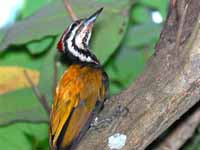
Flameback, Himalayan Dinopium shorii Found: Indian Subcontinent
Description: The Himalayan flameback, aka the Himalayan goldenback, has a golden upper-back more red lower back. The top of the mantle is black and the rump is red. They male has a red crown and crest while for the female they are black with some thin white streaks. There is a wide black eye-line which is bordered by white. There is also a black moustachial stripe. The chin is white with some black streaking. It has predominantly white underparts, with varying amounts of black per individual. It is 30 to 32 cm long. The similar greater flameback has a longer and thinner bill.
Range: Bangladesh, Bhutan, northern India, Myanmar, and Nepal..
Habitat: Mainly deciduous forests at low level in Himalayan region.
Diet: Mainly insects, but little known.
Conservation status: Least Concern.
Image by: 1) Lip Kee - Nepal 2) Eudromias - northern Inda 3) KannanRange: Bangladesh, Bhutan, northern India, Myanmar, and Nepal..
Habitat: Mainly deciduous forests at low level in Himalayan region.
Diet: Mainly insects, but little known.
Conservation status: Least Concern.
1) Female 2, 3) Male
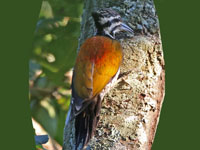
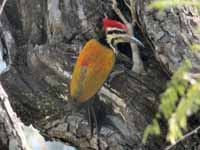
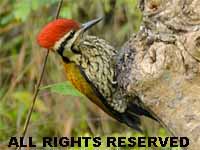
Flameback,_Spot-throated Dinopium everetti
Description: Description: The spot-throated flameback has mainly golden-yellow upperparts, including the wing coverts. It has a black upper-tail. The rump is red. The male has a red crown while the female has a black crown with thin white streaks. The face is white wiith a wide black eye-line that continues to the black napeand a thinner black moustachial stripe. It has a very thin supercilium.
It has a white throat with black spots. The underparts are also white with black scaling. The black-rumped flameback is 28 to 30 cm long and weighs 85 to 100 grams. The buff-spotted flameback is also found in the Philippines, but it does not have black and white face.
Range: Province of Palawan in the Philippines.
Habitat: Primary and secondary forests plus plantations and clearings if there are still standing trees.
Diet: Probably Insects such as ants, beetle larvae, termites.
Conservation status: It is listed as Near Threaten with a declining population due to habitat loss.
Image by: 1) Allan_Barredo - PalawanRange: Province of Palawan in the Philippines.
Habitat: Primary and secondary forests plus plantations and clearings if there are still standing trees.
Diet: Probably Insects such as ants, beetle larvae, termites.
Conservation status: It is listed as Near Threaten with a declining population due to habitat loss.
1) Male
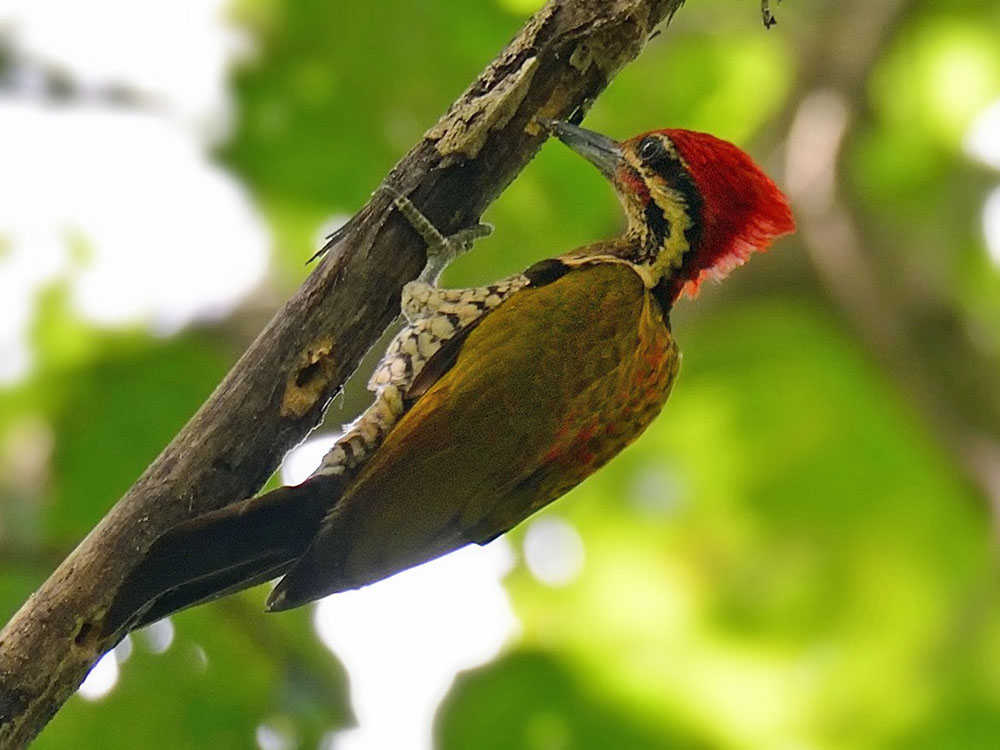
Woodpecker,_Olive-backed Dinopium rafflesii
Description: The olive-backed has yellow-green upperparts and grey-olive underparts. The side of the head has two black and white stripes. The male has a large red crest, the female has a smaller black crest. It is 26 to 28 cm long.
The olive-backed woodpecker may be more closely related to the pale-headed woodpecker (Gecinulus grantia). That is, it my be in the wrong genus.
Range: Southeast Asia.
Habitat: Forests and mangroves; avoids clearings and secondary forest.
Diet: Ants, termites, larvae.
Conservation status: tt is listed as Near Threatened because of forest destruction..
Image by: 1) Hectonichus - stuffed specimen Range: Southeast Asia.
Habitat: Forests and mangroves; avoids clearings and secondary forest.
Diet: Ants, termites, larvae.
Conservation status: tt is listed as Near Threatened because of forest destruction..
